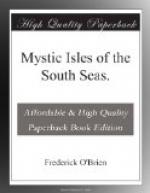“But children nowadays are often brought up by their own parents,” said Mme. Tetuanui, rising to prepare the dejeuner, and I for a swim in the lagoon, “and if adopted, they go from one home to the other as they will. Parents are not as willing as before to let go their children; for whereas my grandmother had fifteen, I have none, and few of us have many. We are made sterile by your civilization. Tetuanui and I were happy and able to persuade the mothers of twenty-five to give their infants to us because we were childless and were chiefs and well-to-do. Our race is passing so fast through the miseries the white has brought us that little ones are as precious as life itself.”
Chapter XVIII
The reef and the lagoon—Wonders of marine life—Fishing with spears and nets—Sponges and hermit crabs—Fish of many colors—Ancient canoes of Tahiti—A visit to Vaihiria and legends told there.
About a mile from the beach was the reef, on which the breakers beat clamorously or almost inaudibly, depending on the wind and the faraway surge of the seas. The Passe of Rautirare afforded entrance for small vessels. It was an opening in the wall about the island caused by the Vairahaha, the stream which emptied into the lagoon at our door, and the fresh waters of which had ages ago prevented the coral zooephytes from building a structure there, as at Papeete and all other passages. Fresh water did not agree with these miraculous architects whose material was their own skeletons.
I went out toward the reef many mornings in a little canoe that Tiura, the eldest son of the chief, loaned me. I carried from the house a paddle and three harpoons of different sizes. The canoe had an outrigger and was very small, so that it moved fast through the usually still lagoon, propelled by the broad-bladed paddle. In the bottom of it might be an inch of water, for occasionally I shipped a tiny wave, but wetness was no bother in this delicious climate; a pareu was easily removed if vexatious and a cocoanut-shell was an ample bale.
Low tide was at sunrise, and warmed with my fruit and coffee, and the happy ia ora na, Maru! of the family, I paddled to the reef with never-failing expectation of new wonders. The marine life of the Tahiti reef is richer than anywhere in these seas, as the soil of the island is more bountiful.
At that state of the tide the surf barely broke upon the reef, and, almost uncovered, its treasures were exposed for a little while as if especially for me. The reef itself was a marvel of contrivance by the blind animals which had died to raise it. If I had been brought to it hooded, and known nothing of such phenomena, I would have sworn it was an old concrete levee. The top was about fifty feet wide, as level as a floor, pitted with innumerable holes, the hiding-places of millions of living forms which fed on one another, and were continually replenished by




